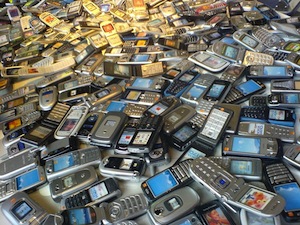 Jeffrey Glueck is the chief executive of Skyfire, a mobile browser startup that optimizes Web content for smartphones. This is a revised version of an article he wrote for the company blog.
Jeffrey Glueck is the chief executive of Skyfire, a mobile browser startup that optimizes Web content for smartphones. This is a revised version of an article he wrote for the company blog.
Relentless exponential progress has become an unquestioned truth in technology. And that’s been for good reason. Yet in smartphones, the industry is about to hit a friction point as we enter the next phase of mobile growth.
Conventional wisdom has held that Moore’s Law, named for Intel co-founder Gordon Moore, would apply to all parts of digital electronic devices. Moore stated that integrated circuits would double in capacity at lower cost every two years – and that has proved true. Most technologists now cite Moore’s law as applicable universally. And those who compare an iPhone or an HTC Evo to what “smartphones” looked like before 2007 certainly have seen incredible advances.
If you look at mobile subsystems only as standalone components, then Moore’s Law will hold. But when combined as a system –- with radio frequency towers, bandwidth, displays, processing and battery –- then we’re all facing serious limits to growth.
June 5th: The AI Audit in NYC
Join us next week in NYC to engage with top executive leaders, delving into strategies for auditing AI models to ensure fairness, optimal performance, and ethical compliance across diverse organizations. Secure your attendance for this exclusive invite-only event.
The first big problem is network capacity. Although networks get better, what matters to users is the download speed for typical use cases, especially in peak hours. Despite major advancements in smartphones and network speeds, the explosion in mobile video traffic of nearly 6000 percent over the next three years will strike as a tsunami. This will create what I term “mobile warming”, the severe strain on mobile networks that could mean slow-loading content, dropped calls, and frequently-buffering video.
4G speeds are touted between four and 12 megabits per second. But once more users sign up for 4G and tax its capacity, and roam farther from towers and behind physical walls, then 4G subscribers are likely to find real life speeds run much slower. Smartphone users will find their experience a long way from what they experience when connected via fixed-line broadband.
Paul Jacobs, the CEO of Qualcomm, said at CTIA last fall that with 4G technology, engineers have squeezed nearly everything possible from limited radio spectrum. He called for the FCC to open up more spectrum. That, however, is probably a seven-year process before going live. This June, Jacobs called on developers to be responsible: “You guys have an obligation to build applications that are as network efficient as possible. We all have a responsibility to be as efficient as we can.”
The trouble is that this is a classic “tragedy of the commons” collective action problem. Any given developer has little incentive to protect the network or sacrifice functionality.
This problem will only partly be alleviated by data quotas being rolled out by AT&T, which are sure to be followed by other operators. The number of users maxing their quotas will keep increasing.
The second problem is that Moore’s Law works wonderfully when applied to devices plugged into a power outlet. More powerful CPUs keep coming, but they eat more power. And when you need a lightweight device that fits in a pocket, a handset maker is constrained on battery size.
Until there’s a major breakthrough in batteries, we just can’t fit much more power into the same size battery. If I do an hour of calls, check email and browse for a couple minutes, I get the red low-battery signal. That is before the demands of video, gaming, video calling, and more.
Unless users are willing to charge their phones every two hours, the jumps in CPU power each year on smartphones will have to slow down.
The two problems — network bandwidth and battery life — get magnified by video. If you complain it’s hard to get a good connection now, wait until the user at the next café table is downloading a 720p HD Flash video on the same 3G network tower you’re sharing. And decoding video that is not optimized for mobile burns battery at incredible rates.
Publisher fragmentation is also why it’s a myth that HTML5 video tags will prove any better at solving the mobile video problem than Flash. In the absence of agreed HTML5 standards, publishers can use any video codec and streaming protocol they want, and any size video. HTML5 by itself will not protect networks from mobile warming.
 It’s very expensive to build and maintain separate sites for each mobile and OS ecosystem. Across 100 million rich media publishers on the web, if even a quarter fail to optimize for mobile, those “polluting” videos can make up the majority of bandwidth hogs on the network.
It’s very expensive to build and maintain separate sites for each mobile and OS ecosystem. Across 100 million rich media publishers on the web, if even a quarter fail to optimize for mobile, those “polluting” videos can make up the majority of bandwidth hogs on the network.
Summing Up
In the end, Moore’s Law at the component level probably will continue to hold true. We are all indebted to Gordon Moore’s insight. But as a system, I’d argue that mobile will face special constraints that will keep a material gap with the desktop Internet, unless special solutions are deployed on the server side.
